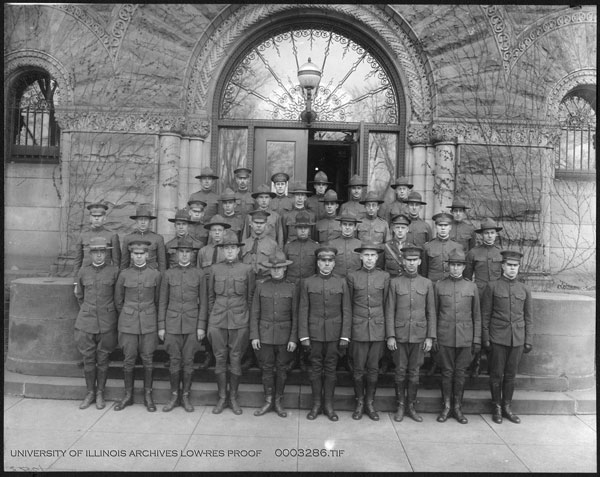Champaign County On Film, the second event in the Town & Gown Speaker Series, will be held in the Lewis Auditorium at Urbana Free Library, Wednesday, October 15, at 7pm. The Champaign County Historical Archives and the Student Life & Culture Archives will present an evening devoted to the changes of Champaign County from the 1920s through the twenty-first century as captured by the film lens. Continue reading “Champaign County On Film”
Author: Angela Jordan
School of Military Aeronautics
The last of four posts written for “WWI and Champaign County” of the Town & Gown Speaker Series, a collaboration between the Student Life & Culture Archives and the Champaign County Historical Archives.
Research for this post contributed by Maggie Cornelius.
Besides ROTC and SATC, the Department of War instituted another military training program at the University of Illinois during World War I. The School of Military Aeronautics (SMA) was not a permanent addition to the University, but its activities preoccupied the campus during the latter years of the Great War.
 In March 1917, the Daily Illini reported on this development: “The aviation section of the military department of the United States has become active during the present crisis and is desirous of interested students at all the universities in aviation.”[1] To meet the nation’s need for pilots in time of war, the federal government commissioned six U.S. universities to open aviation schools. Illinois was the first American university to offer its facilities and resources to the government to aid the war effort.[2] Continue reading “School of Military Aeronautics”
In March 1917, the Daily Illini reported on this development: “The aviation section of the military department of the United States has become active during the present crisis and is desirous of interested students at all the universities in aviation.”[1] To meet the nation’s need for pilots in time of war, the federal government commissioned six U.S. universities to open aviation schools. Illinois was the first American university to offer its facilities and resources to the government to aid the war effort.[2] Continue reading “School of Military Aeronautics”
Student Military Training and the Great War
The third of four posts written for “WWI and Champaign County” of the Town & Gown Speaker Series, a collaboration between the Student Life & Culture Archives and the Champaign County Historical Archives.
Research for this post contributed by Maggie Cornelius.
America’s entry into World War I required the mobilization of the country’s brightest minds and ablest bodies for military training and leadership. The War Department looked to American universities to recruit capable men for its military departments. These recruitment efforts prompted the establishment of two prominent military organizations at the University of Illinois, both of which served as the foundation for the current Illini Reserve Officers’ Training Corps (ROTC) program. 
Prior to ROTC, the 1862 Morrill Act obligated land-grant universities to instruct its male students in “military tactics.”[1] Anticipating the American entrance into the war, the National Defense Act of 1916 established the ROTC as part of its reorganization of the American military. Illinois created its ROTC chapter in 1917 and fundamentally changed how the University fulfilled its Morrill Act obligation. ROTC’s primary purpose was to train and enroll men into the Reserved Officers’ Corps who were qualified to be “captains or lieutenants of volunteer organizations in times of war.”[2] In its early days, ROTC was divided into seven units: medical corps, signal corps, engineers, cavalry, field artillery, coast artillery, and infantry.[3] Continue reading “Student Military Training and the Great War”
The Women Behind the Men Behind the Guns
The second of four posts written for “WWI and Champaign County” of the Town & Gown Speaker Series, a collaboration between the Student Life & Culture Archives and the Champaign County Historical Archives.
Research for this post contributed by Maggie Cornelius.
The United States government asked Americans to knit socks, sweaters, and other garments for soldiers during World War I. Most of this knitting was produced by volunteers working under the auspices of the American Red Cross. Illini women, like many women during the war, devoted their free time and money to contribute necessities and luxuries to the war effort. The former provided subsistence and the latter provided morale. Continue reading “The Women Behind the Men Behind the Guns”
Illini Ambulance Volunteers, 1917
One of four posts written for “WWI and Champaign County” of the Town & Gown Speaker Series, a collaboration between the Student Life & Culture Archives and the Champaign County Historical Archives.
Research for this post contributed by Maggie Cornelius.
University of Illinois students found multiple ways to aid the Allies in Europe prior to the U.S. entry in April of 1917. Among the students who traveled to war zones was a committee of volunteer ambulance drivers. On May 15, 1917, over twenty Illini men set sail for France to help deliver the wounded from the front to military hospitals.[1] The chairman of this Ambulance Committee was Christian “Chris” Gross. An agriculture student and a member of the Daily Illini editorial board, Sigma Delta Chi, Alpha Gamma Rho, and Psi Upsilon,[2] Gross organized and sent volunteer ambulance drivers to Europe for a six-month stint. Continue reading “Illini Ambulance Volunteers, 1917”